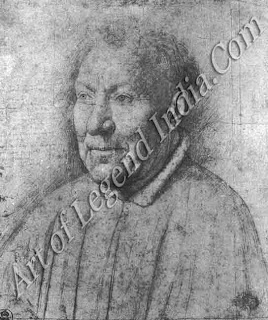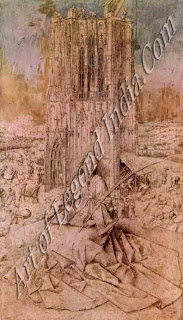Netherlandish Great Artist Jan Van Eyck - Jewel like Perfection
Posted by
Art Of Legend India [dot] Com
On
11:34 PM
The
works of Jan van Eyck are celebrated for their visual splendour and precision
of detail. Their brilliant colours and magnificent definition are due to Jan's
refinement of the oil-painting technique.
Jan van
Eyck was highly praised in his own time, and is traditionally renowned as the
founder of the Netherlandish school of painting. His fame rests largely on the
illusion of reality he created in his paintings and his delight in naturalistic
detail and rich, decorative effects.
Little
is known of Van Eyck's early career, and the paintings which survive are those
of a mature artist, well-practiced in his craft. Most of Van Eyck's work for
Philip of Burgundy was of a decorative and temporary nature, and has long since
disappeared. His surviving works were painted for rich and aristocratic
patrons, men moving in court circles. For them Van Eyck created majestic
Madonnas, rather than the more homely women of his contemporary, Robert Campin,
who worked for bourgeois patrons. Even when placing the Virgin and Child in a
domestic setting, then popular, Van Eyck elevated his Madonna on a throne-like
chair, with a brocaded canopy overhead and rich carpet underfoot. Elsewhere in
The Ghent Altarpiece and The Madonna with Canon van der Paele he depicted the
material splendour of bejewelled robes and crowns to speak of the richness of
heaven.
This
was a period of growing demand for life-like portraits, and a time when faith
was direct and called for clear and 'real' images of religious doctrine. Van
Eyck responded by exploiting his acute powers of observation and his formidable
technique to produce unique illusions of reality. Whilst Van Eyck observed the
world around him, he never attempted to reproduce it with topographical
accuracy. Instead, he used his knowledge to create imaginative landscapes,
townscapes and interiors that would appear familiar to his patrons. The
background to The Madonna with Chancellor Rolin has the feel of the River
Meuse, but the town cannot be identified.
By the
1430s, Van Eyck broke with tradition and refined a new plateau-type
composition, where the foreground figures appear to be higher in the imagined
space than those in the background. This enabled him to develop his interest in
landscapes with far-reaching vistas. He also began to explore the relationship
between interior and exterior, looking through a window or over a parapet, and
was perhaps the first painter to present the back view of figures gazing into
the landscape, in The Madonna with Chancellor Rolin.
The
exact, scientific perspective developed in Florence was unknown in Flanders,
but Van Eyck explored an empirical method of perspective to paint his
interiors. By the time of the compelling Arnolfini Wedding, he was perfectly
able to create the novel effect of a real space opening forward, which seemed
to continue beyond the frame and include the viewer.
Symbolism
is an important element in Van Eyck's religious and secular works. In The
Arnolfini Wedding he was concerned to include numerous symbols of faith,
without disrupting the overall natural effect. The symbols appear at first
sight to be everyday objects, but Van Eyck probably chose them for their
traditional symbolism: a lighted candle in a chandelier indicating the presence
of God, a griffon terrier, fidelity, a carafe of water, the purity of the
Virgin, and a beam of light through a window, the Incarnation.
Vasari
and other early biographers credited Van Eyck with the invention of oil
painting. In fact it had been known for many years but was used in a limited
way. However, in Van Eyck's time, improved varnishes, diluents and driers were
distilled, and Jan explored the possibilities of their use with an
unprecedented sophistication. He painted on the usual wooden panel covered with
a smooth layer of gesso (plaster), then, and after beginning his work with
opaque paint, he would apply many thin layers of translucent, oil-based colour
glazes to achieve the glowing and luminous effects characteristic of his work.
It was
Van Eyck's technical expertise that enabled him to reproduce the visual world
convincingly. His figures are enhanced by natural lighting and on occasion he
even created the illusion of a foot or angel's wing projecting forward out of
the picture. He also delighted in the precise rendering of texture.
Van
Eyck's contribution to portraiture was also significant. He abandoned the
Gothic tradition of exaggerated physical features in favour of a life-like
description of the individual face. He realized that the three-quarter view,
with head turned halfway between profile and full-face, could be much more
naturalistic than the conventional profile. He understood that if the face was
turned towards the light, he could use the shadow playing over the visible side
to describe minute details of the surface. With his usual ingenuity, he
explored ways to include the hands to greatest effect, and experimented with
the impact of a novel device a direct glance out of the picture.
Van
Eyck also appears to have given considerable thought to the inclusion of
appropriate inscriptions in many of his works. These were often incorporated
into the painting itself, or worked into the picture frame. The motto 'As Best
I Can' appears several times, reflecting a pride in his work and a becoming
humility.
Writer
– Marshall Cavendish
Subscribe to:
Post Comments (Atom)
















0 Response to "Netherlandish Great Artist Jan Van Eyck - Jewel like Perfection "
Post a Comment